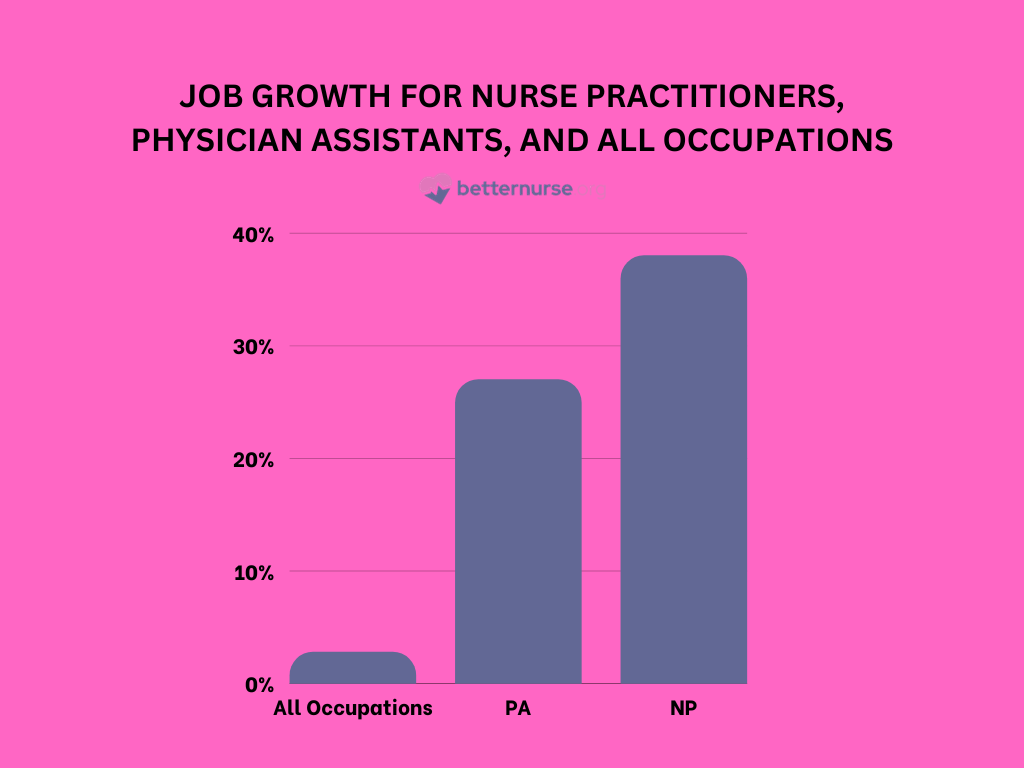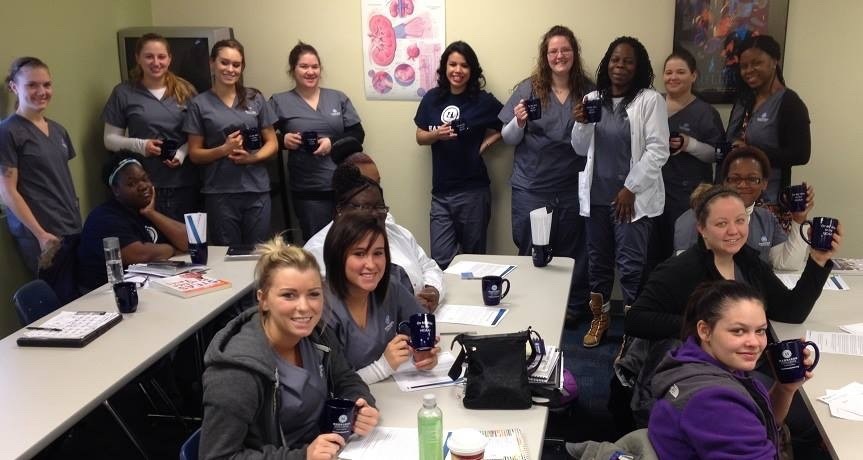There is significant overlap in the duties of a nurse practitioner and physician assistant. After all, they can both assess patients, diagnose and treat illnesses, and in many cases even prescribe medication.
However, there are some key differences between NPs and PAs. Most notable is in their separate approaches to care. While an NP uses the nursing model, a PA uses the medical model.
Because of these different models, nurse practitioners and physician assistants require different education, training, certification, and licensure. There are also differences in specializations, level of autonomy, and more.
So, in this article we’ll explore these differences in depth, and help you understand which career path may be the better choice for you.
Table of contents
- What Is A Nurse Practitioner?
- What Is A Physician Assistant?
- Nurse Practitioner vs Physician Assistant: 5 Key Differences
- Pros And Cons of Nurse Practitioner vs Physician Assistant
- Nurse Practitioner vs Physician Assistant Salary
- Nurse Practitioner vs Physician Assistant Job Outlook
- Which Is Better, NP or PA?
- Nurse Practitioner vs Physician Assistant FAQs
What Is A Nurse Practitioner?
A Nurse Practitioner is a type of Advanced Practice Registered Nurse, or APRN, providing a wide range of healthcare services. While specific nurse practitioner duties can vary depending on state laws, in general they perform the following:
- Serving as patients’ primary healthcare provider
- Diagnosing and treating medical conditions
- Prescribing medications
- Patient education and preventative care
- Chronic disease management
Many NPs also choose to pursue a nursing speciality, like psychiatric-mental health, pediatrics, and lots more. They are also educated and trained in the nursing model, which stresses both the physical and emotional needs of patients.
It’s worth noting that, in some states, nurse practitioners can work independently. However, other states require them to work under the supervision of a physician.
To become an NP, you need to earn either a Master’s- or Doctoral-level nursing degree after becoming a licensed RN. You’ll also need to obtain the proper certifications and licensure to practice in your state.
What Is A Physician Assistant?
A Physician Assistant is a medical professional that provides patient care under the supervision of a physician. Like physicians, PAs can make clinical decisions and provide a large range of services. For example, they can:
- Diagnose and treat illnesses
- Perform minor procedures
- Prescribe medications
However, their specific duties and level of autonomy is dependent on the guidelines set forth by their supervising physician. Unlike NPs, PAs cannot set up their own independent practice in any state.
Additionally, PAs are trained using the medical model, which stresses the use of clinical medicine and is less concerned with patients’ emotional needs.
To become a PA, you need to earn your Master’s of Science in Physician Assistant degree. These programs typically last about three years of full-time study. Finally, you have to pass a certification exam and obtain licensure to begin practicing.
Nurse Practitioner vs Physician Assistant: 5 Key Differences

The main difference between nurse practitioners and physician assistants is that NPs provide care with a broader focus on patients’ overall environments, lifestyle, and psychosocial factors. Meanwhile, PAs focus more heavily on biological and pathological aspects of health.
In other words, a PA approaches patient care from a medical perspective, while an NP approaches it from a more holistic perspective.
Because of this difference in approach, there are quite a few differences between them, including educational background and scope of practice.
Below, we discuss all the key differences between a nurse practitioner and physician assistant.
1. Educational Background & Training
| Nurse Practitioners | Physician Assistants | |
| Minimum Degree Requirement | MSN with focus in NP speciality | Master’s of Science in Physician Assistant |
| Program Prerequisites | BSN degree; Active RN license; 1 to 2 years of RN experience | Bachelor’s degree; 3 years of healthcare experience |
| Time To Complete Degree | MSN-NP programs typically require 1.5 to 3 years of full-time enrollment | PA programs typically require 3 years of full-time enrollment |
| Clinical Hours Required | 750+ | 2,000+ |
| Type of Training | Nursing Model; Holistic approach; NPs choose a specialty | Medical Model; Biological/physiological approach PAs receive generalist education and do not choose a speciality |
| School Accreditation Body | ACEN; CCNE | ARC-PA |
Though NPs and PAs both require at least a master’s degree, their educational backgrounds are different.
After earning their BSN and gaining some RN experience, NPs must enter an MSN or DNP program with a nurse practitioner focus. They’ll typically choose to pursue a particular speciality, like Family Nurse Practitioner or Psychiatric Mental Health.
Additionally, they have to complete clinical hours. While the exact number of hours can vary by program, The National Task Force (NTF) for Quality Nurse Practitioner Education requires a minimum of 750 direct patient care clinical hours.
These programs prepare students to deliver whole-patient care, including aspects of disease prevention and health education.
Meanwhile, physician assistants usually require a bachelor’s degree and at least three years of healthcare experience before applying to PA school.
From there, aspiring PAs have to enter a Master of Science in Physician Assistant degree. These programs typically take about three years to complete, and prepare students through a medical model, like a condensed medical school.
Like nurse practitioners, PAs must complete clinical experience during their programs. However, they require a lot more clinical hours than NPs. In fact, physician assistants typically need to complete 2,000 hours.
2. Scope of Practice & Prescriptive Authority
The scope of practice can also be different depending on whether you’re an NP or PA. While nurse practitioners’ autonomy varies based on the state, physician assistants must generally practice under the supervision of a physician.
The level of autonomy of NPs falls into three categories:
- Full Practice Authority: NPs can work independently of a physician and even operate their own practices in states like Hawaii and Maryland
- Reduced Practice Authority: NPs can diagnose and treat patients, but can only prescribe medications with physician oversight in states like New York and Pennsylvania
- Restricted Practice Authority: NPs must have physician oversight in order to diagnose and treat patients, as well as prescribe medications
Meanwhile, physician assistants cannot practice independently, and they are restricted by the supervising physician’s guidelines. Depending on these guidelines, the level of autonomy for PAs can vary.
However, because of their medical focus and training, they often complete a wide range of autonomous duties.
3. Specializations

Nurse practitioners and physician assistants also differ in how they go about pursuing or switching their specialization.
An NP typically chooses a nursing specialty when they earn their master’s degree. Common nurse practitioner specialities include:
- Family Nurse Practitioner (FNP)
- Pediatric Nurse Practitioner (PNP)
- Adult-Gerontology Nurse Practitioner (AGNP)
- Psychiatric Mental Health Nurse Practitioner (PMHNP)
- Neonatal Nurse Practitioner (NNP)
- Women’s Health Nurse Practitioner (WHNP)
- Emergency Nurse Practitioner (ENP)
- Acute Care Nurse Practitioner (AGACNP)
Each of these requires a long-term commitment to completing your education, certification, and licensure in one particular patient population or medical specialty.
On the other hand, PA programs train students in general medicine, giving them more flexibility in selecting a speciality.
Better yet, if they wish to switch medical specialities, they can do so without gaining additional formal education and training.
4. Certification and Licensing
| Nurse Practitioners | Physician Assistants | |
| Certification Exam | The exam you take depends on your NP specialty | Physician Assistant National Certifying Examination (PANCE) |
| Minimum License Requirements | -Hold active RN license; -Hold MSN degree in an NP speciality -Pass national certification exam | Hold Master’s of Science in Physician Assistant degreePass PANCE exam |
| Licensing Body | State board of nursing | State medical board or equivalent agency |
| Recertification | -Recertify every 5 years; -Minimum of 1,000 practice hours as NP in your population focus area within 5-year certification period; -Minimum of 100 contact hours of continuing education (CE) -Hold current RN licensure; -You can also just recertify by examination if you hold an active RN license | -Log 100 hours of continuing medical education (CME) credits and pay a maintenance fee every 5 years -Pass recertification exam by end of 10th year |
While nurse practitioners and physician assistants both require certifications and licensing, their specific credentials are different.
Once NPs complete their MSN program, they must then pass a national certification exam. The specific test you need to take depends on your speciality. For example, there are different certifications for FNP, NNP, ENP, and more.
After earning certification, they need to apply for a license from the state board of nursing of the state they wish to work in.
Once physician assistants earn their master’s degree, they must pass the Physician Assistant National Certifying Examination (PANCE) exam. The test is administered by the National Commission on Certification of Physician Assistants (NCCPA).
Finally, after passing the PANCE, PAs have to gain licensure from the state medical board in which they plan to practice in.
5. Career Progression

Lastly, the career paths of nurse practitioners and physician assistants typically progress in different directions.
First, experienced NPs can take on advanced roles, like:
- Managing healthcare teams
- Directing nursing departments
- Overseeing community health programs
They’ll also be well-prepared to pursue a Doctorate of Nursing Practice, opening their prospects up to esteemed positions. For example, this might include policy-making roles and executive leadership opportunities.
One more exciting opportunity for nurse practitioners is opening their own independent practice. Just keep in mind that not all states give NPs full practice authority.
On the other hand, one of the great things about becoming a physician assistant is the flexibility to switch specialities without additional formal education. This allows them to explore several areas of medicine and have a diverse range of experiences.
After gaining some experience, many PAs advance to supervisory roles and administrative positions. Some also choose to transition into academic or research roles, or become leaders of healthcare teams and departments.
Pros And Cons of Nurse Practitioner vs Physician Assistant
Becoming a nurse practitioner and physician assistant both come with their own unique set of benefits and challenges.
In the chart below, we provide a brief snapshot of the pros and cons of both NPs and PAs.
| Nurse Practitioners | Physician Assistants | |
| Pros | -Autonomy in practice -Specialization from the start -Nursing model -Opportunities for independent practice -Open to opportunities in education, research, administration, or policy roles -Great job outlook and relatively high salary | -Flexibility in specialization -Team-based approachMedical model -Training is unspecialized and largely consistent across programs -Great job outlook and relatively high salary |
| Cons | -Autonomy in practice is reduced or restricted in many states -Changing your speciality can be difficult | -No autonomous practice or independent clinic ownership -Scope of practice is dependent on the supervising physician |
Nurse Practitioner vs Physician Assistant Salary
The average salaries for nurse practitioners and physician assistants aren’t too far apart. However, on average, PAs do make $4,440 more a year than NPs.
According to BLS, the average annual salary for physician assistants is $126,010 per year. Meanwhile, they report the average annual salary for nurse practitioners is $121,610.
Interestingly though, the bottom 10% of NPs makes $87,340 per year, while the bottom 10% of PAs makes $83,820. The top 10% of NPs makes $165,240, while the top 10% of PAs makes $168,120.
It’s also worth noting that some NP specialties typically pay more than others. For example, the second-highest nursing specialty, Neonatal Nurse Practitioner, makes an average annual salary of $136,101.
So, depending on your particular speciality, you may be able to make more money as a nurse practitioner.
Nurse Practitioner vs Physician Assistant Job Outlook

The job outlook for nurse practitioners and physician assistants is extremely positive. In fact, the growth rate for both occupations is much faster than average.
BLS only provides job outlook data for a combination of NPs, Nurse Anesthetists, and Nurse Midwives. However, they report that overall employment for these positions is expected to grow 38% from 2022 to 2023.
Meanwhile, they project that overall employment for PAs is expected to grow 27% from 2022 to 2023.
So, whether you pursue becoming an NP or a PA, both careers provide stable employment prospects. However, nurse practitioners do look set to become the more in-demand position, as employment is growing 10% faster than physician assistants.
Which Is Better, NP or PA?
Whether becoming an NP or a PA is better depends on your own personal interests, preferences, and circumstances.
If you’re interested in working autonomously, you’re likely better off pursuing the nurse practitioner path. The same may be true if there’s a specific specialty you’re passionate about, like pediatrics or women’s health.
On the other hand, if you want to explore a wide range of areas in medicine or you’re not what you’d specialize in, the PA pathway may be the better option.
Perhaps most importantly, you should consider which healthcare approach you prefer.
If you prefer the nursing model’s psychosocial/holistic approach, then NP makes the better option. However, if you prefer the medical model’s biological/physiological approach, PA makes the better choice.
Nurse Practitioner vs Physician Assistant FAQs
Is A Physician Assistant Above A Nurse Practitioner?
Physician assistants are not above nurse practitioners. In fact, they have no hierarchical relationship in the healthcare system.
Instead, they are different career pathways with different approaches to care, education, and training. Ultimately, your career choice should align with your preferred approach to care.
So, a PA is not higher up than a nurse practitioner, because they each play separate critical roles in delivering patient care.
Is It Harder To Get Into NP Or PA School?
While both NP and PA schools both provide comprehensive education in delivering patient care, PA school does tend to be harder to get into.
In fact, the average PA school acceptance rate is only 20%. Top-ranked programs, like Duke University and Emory University, often have acceptance rates as low as 2% or 3%.
While some top-rated NP programs may have low acceptance rates, there are a significant number of programs with high acceptance rates. In fact, some nursing schools regularly admit 80% or more of applicants.
Additionally, physician assistant programs typically require applicants to have more hands-on experience than NPs. While PAs usually need about three years of previous clinical experience, MSN-NP programs usually only require one to two years.
Finally, some students may find PA programs’ intensive focus on all medical specialities and patient populations more challenging. However, both pathways fully prepare and qualify you to deliver quality care to patients.
What Can A PA Do That An NP Cannot?
The main thing that a PA can do that an NP cannot is work within different specialities without gaining additional formal education or certification.
This is because PAs receive generalist medical training, as opposed to nurse practitioners, who receive specialized training during their programs.
It’s also worth noting that, because of this generalist training, physician assistants often play a larger role in surgical settings.
Nurse Practitioner vs Physician Assistant vs Doctor: What’s The Difference?
We’ve already covered the fact that a nurse practitioner and physician assistant mainly differ in their approach to care and educational background. Like PAs, doctors also take a medical approach to care.
However, unlike NPs and PAs, doctors must attend medical school and undergo a residency program. While medical school typically lasts about four years after obtaining a Bachelor’s degree, residency can last anywhere from three to seven years.
Doctors can also specialize in a wide array of fields, from primary care to highly-specialized surgical fields. Some may even choose to complete additional years in a fellowship for sub-specialization.
Overall, this advanced education and training gives them the knowledge and skills they need to provide care autonomously. They can do everything from perform surgeries to lead healthcare teams.
Is A PA Basically A Doctor?
While the duties of a PA and a doctor certainly overlap quite a bit, there are some key differences between them.
First, a PA only needs to complete a three-year master’s program, whereas doctors must attend medical school and complete a residency program, which can take seven to fourteen years.
Because of this additional education and training, doctors are qualified to practice independently, make key clinical decisions, and perform surgeries.
Meanwhile, physician assistants must practice under the supervision of a physician, and must abide by that physician’s guidelines.
Finally, while PAs have significant flexibility in being able to change specialities, doctors do not.
Doctors typically specialize during their residency training and are often board-certified in a specific area of medicine. In order to change specialization, a doctor may have to return to residency.
Overall, PAs play a critical role in providing care to patients and complementing the healthcare team, while doctors lead the teams and make high-level decisions.
Why Choose PA Over MD?
Becoming a doctor is a great career path for many, but there are plenty of reasons to choose becoming a PA over an MD.
First, it’s much quicker to become a physician assistant. Whereas PA programs typically last about 3 years, becoming a doctor requires four years of medical school and three to seven years of residency. It can take even longer if you pursue a fellowship.
Of course, since PA programs are shorter, they’re also more affordable. While doctors do earn more than physician assistants, PAs also take on less debt and start earning money sooner.
Additionally, PAs typically have a better work-life balance than MDs. Depending on their specialty, doctors often work longer hours and generally have a more demanding schedule.
Physician assistants also have more flexibility in their specialization. While doctors must specialize during residency, PAs are generalists and can work in a variety of specialities without extra formal education or training.

Nurse Luke is a CRNA who specializes in Nursing content and still enjoys a very busy career with Locum, Per Diem and Travel nursing in the greater midwest. He has over 25 years of experience in the healthcare field and received his CRNA masters degree from the Mayo Clinic School of Healthcare. He is passionate about helping nurses explore the options of becoming a travel nurse as well as spending time with his Family.



